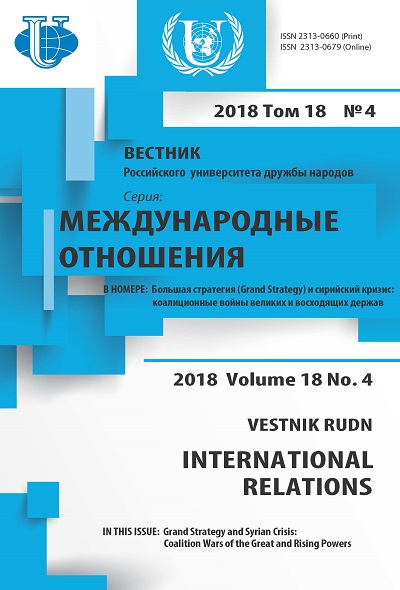Эссе о феномене тотализации войны
- Авторы: Гаджиев К.С.1
-
Учреждения:
- Национальный исследовательский институт мировой экономики и международных отношений Российской академии наук им. Е.М. Примакова
- Выпуск: Том 18, № 4 (2018): Большая стратегия (Grand Strategy) и сирийский кризис: коалиционные войны великих и восходящих держав
- Страницы: 859-871
- Раздел: МИР И БЕЗОПАСНОСТЬ
- URL: https://journals.rudn.ru/international-relations/article/view/20328
- DOI: https://doi.org/10.22363/2313-0660-2018-18-4-859-871
- ID: 20328
Цитировать
Полный текст
Аннотация
Мир, свободный от войн и кровопролитных конфликтов, был идеалом, который всегда проповедовали лучшие умы человечества. Но человек воевал в глубокой древности, он продолжает сражаться в наши дни и, видимо, будет сражаться, пока существуют человеческие сообщества. Представления о типах и характере войн и армий, оборонительных систем, средств и методов ведения войны, соответствующих изменяющимся реалиям, развивались, но во все времена человеческие сообщества в различных формах и ипостасях не считали мир высшим благом. Во многих отношениях история самого человечества предстает как непрерывная серия войн племен, народов, наций, империй, кланов, партий и т.д. Некоторые пытались подчинить чужие страны и народы, другие жаждали воинской славы, в то время как третьи считали, что лучше умереть стоя, чем жить на коленях. В любом случае оправдания для войн всегда находились наиболее убедительные, поскольку человек, судя по его поступкам, действовал так, как будто подсознательно руководствовался мефистофельскими принципами - в мире нет ничего, что заслуживало бы жалости. Также не случайно, что с давних времен скептики никогда не переставали утверждать, что homo homini lupus est , то есть человек человеку волк. И из этой формулы вытекает другой, не менее известный постулат - bellum omnium contra omnes , то есть война всех против всех. Однако это только одна сторона истории человечества. Другая сторона заключается в том, что состояние абсолютной, бесконечной войны всех против всех будет чревато перспективой взаимного уничтожения стран и народов. Противоположностью войны является мир, каждая война заканчивается миром, и разные племена, народы, человеческие общества и государства с самого начала стремились к некоему образу жизни, а также к общепринятым и уважаемым нормам и правилам, которые его обеспечивают. В настоящей статье автор анализирует причины и формы тотализации войны за последнее столетие, особенно в контексте таких тенденций, как глобализация, информационная и телекоммуникационная революция.
Ключевые слова
Об авторах
Камалудин Серажудинович Гаджиев
Национальный исследовательский институт мировой экономики и международных отношений Российской академии наук им. Е.М. Примакова
Автор, ответственный за переписку.
Email: gajievks@mail.ru
доктор исторических наук, профессор, главный научный сотрудник Национального исследовательского института мировой экономики и международных отношений РАН им. Е.М. Примакова
Список литературы
- Гаджиев К.С. Гибридные войны в современном мире // Власть. 2016. Т. 24. № 10. С. 218—223.
- Гаджиев К.С. Метаморфозы конфликтов и войн в современном мире // Международная жизнь. 2016. № 9. С. 129—145.
- «Гибридные войны» в хаотизирующемся мире XXI века / под ред. П.А. Цыганкова. М.: Изд-во Московского ун-та, 2015.
- Людендорф Э. Ведение тотальной войны // Военный зарубежник. 1936. № 4. С. 10—12.
- Най Дж. «Мягкая» сила и американо-европейские отношения // Свободная мысль—XXI. 12 сентября 2004.
- Blair A.A. Global Alliance for Global Values. London: Foreign Policy Centre, 2006. URL: https://fpc.org.uk/wp-content/uploads/2006/09/798.pdf (accessed: 12.09.2018).
- Freedman L. The Future of War: A History. 1st ed. NY: Public Affairs, 2017.
- Hoch М. Krieg und Politik im 21. Jahrhundert. Aus Politik und Zeitgeschichte // Beilage zur Wochenzeitung Das Parlament. 11 Mai, 2011.
- Kaldor M. Global Security Cultures. 1st ed. Cambridge: Polity, 2018.
- Kaldor M. New & Old Wars: Organized Violence in a Global Era. 3rd ed. Stanford, California: Stanford University Press, 2012.
- Keeley L. War before Civilization. NY: Oxford University Press, 1996.
- McPherson J. Battle Cry of Freedom: The Civil War Era. NY: Oxford University Press, 1988.
- Rothkopf D. In Praise of Cultural Imperialism // Foreign Policy, Summer 1997. N 107. P. 45—46.
Дополнительные файлы










